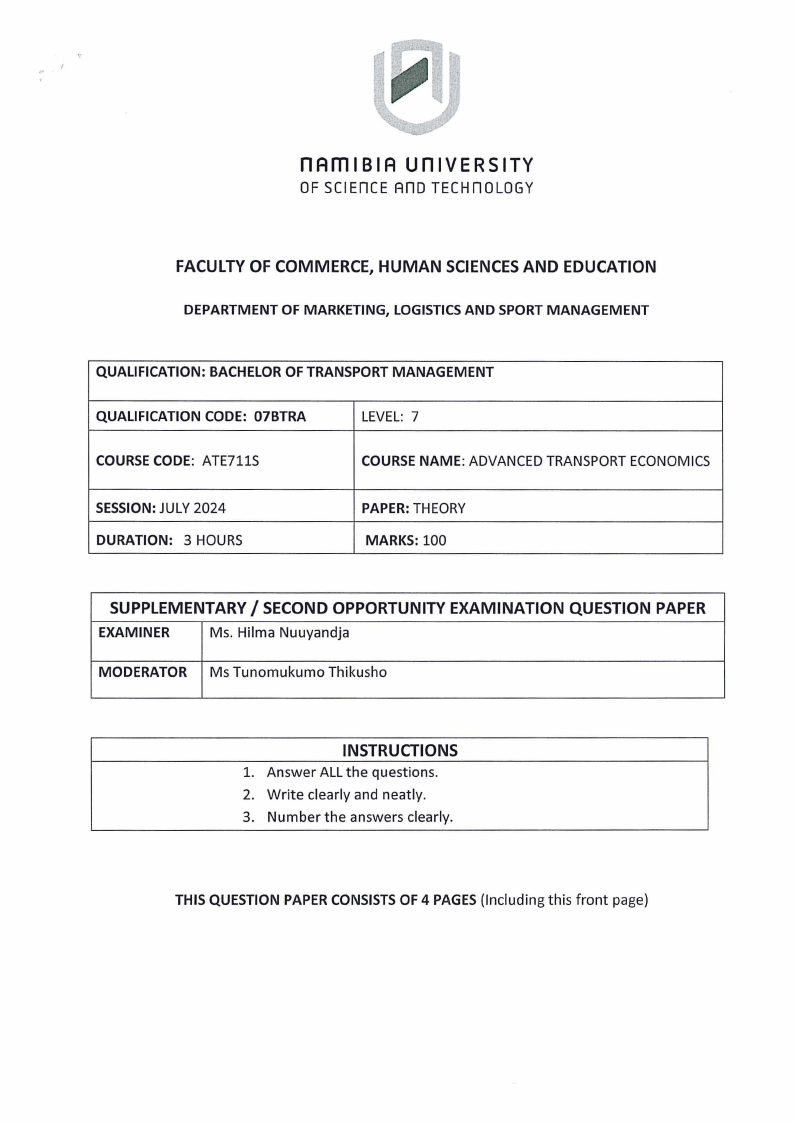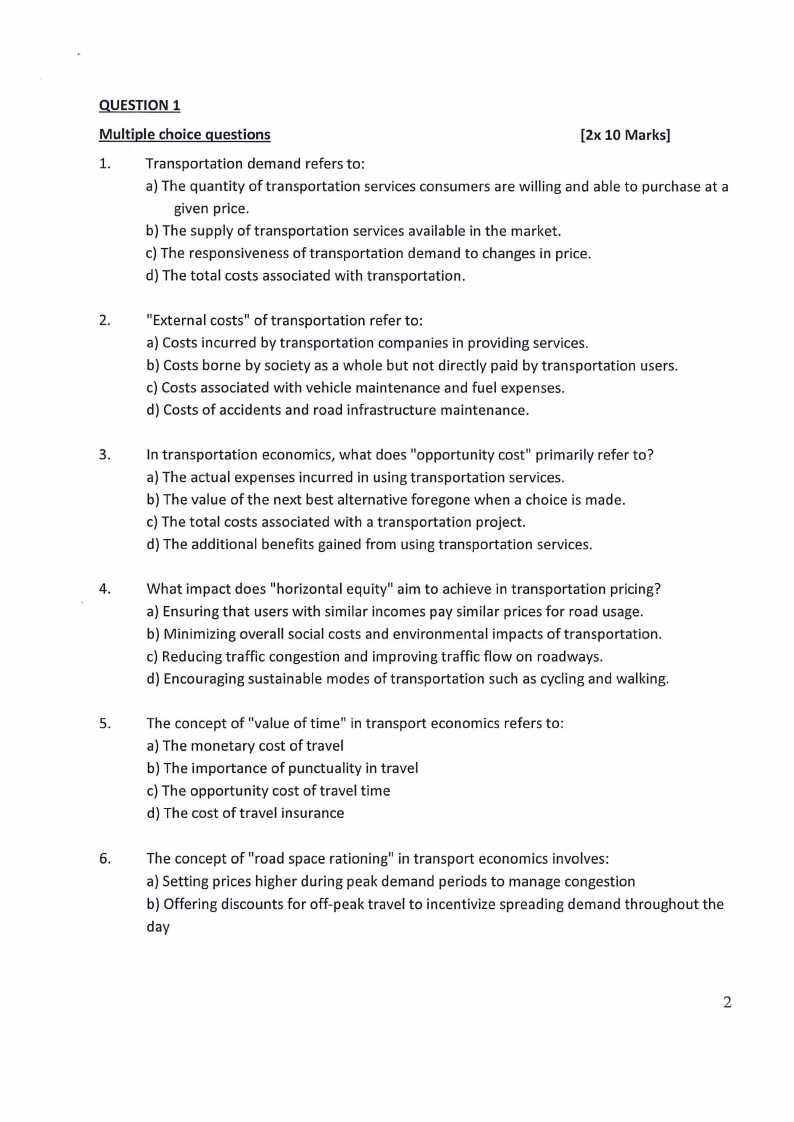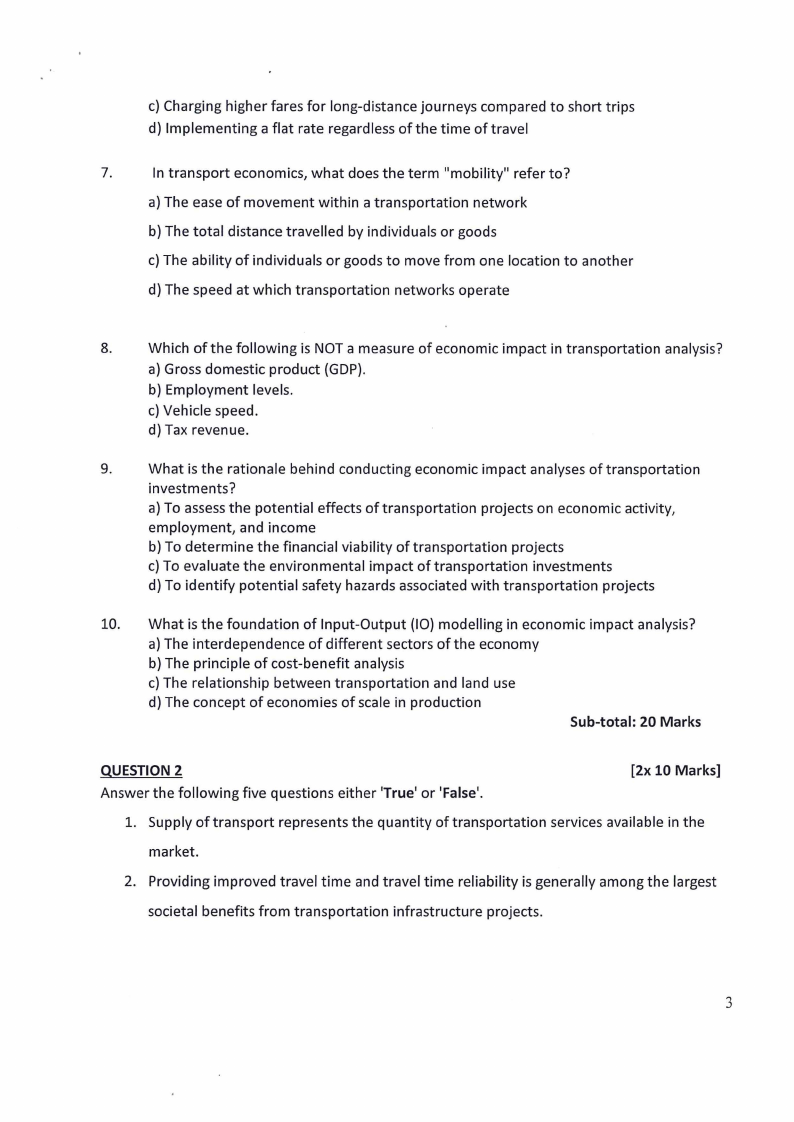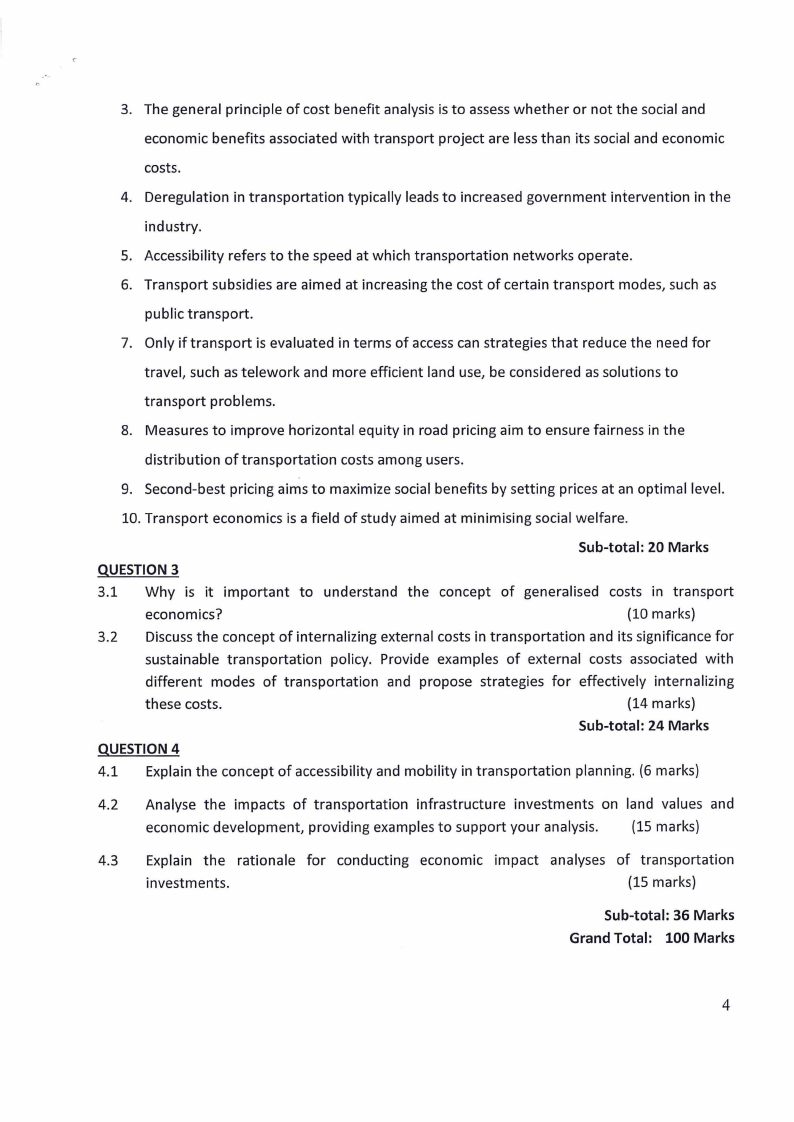 |
ATE711S- ADVANCE TRANSPORT ECONOMICS- 2ND OPP- JULY2024 |
 |
1 Page 1 |
▲back to top |

nAmlBIA unlVERSITY
OF SCIEnCE TECHnOLOGY
FACULTY OF COMMERCE, HUMAN SCIENCESAND EDUCATION
DEPARTMENT OF MARKETING, LOGISTICS AND SPORT MANAGEMENT
QUALIFICATION: BACHELOR OF TRANSPORT MANAGEMENT
QUALIFICATION CODE: 07BTRA
LEVEL: 7
COURSE CODE: ATE711S
COURSE NAME: ADVANCED TRANSPORT ECONOMICS
SESSION: JULY 2024
DURATION: 3 HOURS
PAPER: THEORY
MARKS: 100
SUPPLEMENTARY/ SECOND OPPORTUNITY EXAMINATION QUESTION PAPER
EXAMINER
Ms. Hilma Nuuyandja
MODERATOR Ms Tunomukumo Thikusho
INSTRUCTIONS
1. Answer ALL the questions.
2. Write clearly and neatly.
3. Number the answers clearly.
THIS QUESTION PAPER CONSISTS OF 4 PAGES (Including this front page)
 |
2 Page 2 |
▲back to top |

QUESTION 1
Multiple choice questions
[2x 10 Marks]
1. Transportation demand refers to:
a) The quantity of transportation services consumers are willing and able to purchase at a
given price.
b) The supply of transportation services available in the market.
c) The responsiveness of transportation demand to changes in price.
d) The total costs associated with transportation.
2.
"External costs" of transportation refer to:
a) Costs incurred by transportation companies in providing services.
b) Costs borne by society as a whole but not directly paid by transportation users.
c) Costs associated with vehicle maintenance and fuel expenses.
d) Costs of accidents and road infrastructure maintenance.
3.
In transportation economics, what does "opportunity cost" primarily refer to?
a) The actual expenses incurred in using transportation services.
b) The value of the next best alternative foregone when a choice is made.
c) The total costs associated with a transportation project.
d) The additional benefits gained from using transportation services.
4.
What impact does "horizontal equity" aim to achieve in transportation pricing?
a) Ensuring that users with similar incomes pay similar prices for road usage.
b) Minimizing overall social costs and environmental impacts of transportation.
c) Reducing traffic congestion and improving traffic flow on roadways.
d) Encouraging sustainable modes of transportation such as cycling and walking.
5.
The concept of "value oftime" in transport economics refers to:
a) The monetary cost of travel
b) The importance of punctuality in travel
c) The opportunity cost of travel time
d) The cost of travel insurance
6. The concept of "road space rationing" in transport economics involves:
a) Setting prices higher during peak demand periods to manage congestion
b) Offering discounts for off-peak travel to incentivize spreading demand throughout the
day
2
 |
3 Page 3 |
▲back to top |

c) Charging higher fares for long-distance journeys compared to short trips
d) Implementing a flat rate regardless of the time of travel
7.
In transport economics, what does the term "mobility" refer to?
a) The ease of movement within a transportation network
b) The total distance travelled by individuals or goods
c) The ability of individuals or goods to move from one location to another
d) The speed at which transportation networks operate
8.
Which of the following is NOT a measure of economic impact in transportation analysis?
a) Gross domestic product (GDP).
b) Employment levels.
c) Vehicle speed.
d) Tax revenue.
9.
What is the rationale behind conducting economic impact analyses of transportation
investments?
a) To assessthe potential effects of transportation projects on economic activity,
employment, and income
b) To determine the financial viability of transportation projects
c) To evaluate the environmental impact of transportation investments
d) To identify potential safety hazards associated with transportation projects
10. What is the foundation of Input-Output {10) modelling in economic impact analysis?
a) The interdependence of different sectors of the economy
b) The principle of cost-benefit analysis
c) The relationship between transportation and land use
d) The concept of economies of scale in production
Sub-total: 20 Marks
QUESTION 2
Answer the following five questions either 'True' or 'False'.
[2x 10 Marks]
1. Supply of transport represents the quantity of transportation services available in the
market.
2. Providing improved travel time and travel time reliability is generally among the largest
societal benefits from transportation infrastructure projects.
3
 |
4 Page 4 |
▲back to top |

3. The general principle of cost benefit analysis is to assesswhether or not the social and
economic benefits associated with transport project are less than its social and economic
costs.
4. Deregulation in transportation typically leads to increased government intervention in the
industry.
5. Accessibility refers to the speed at which transportation networks operate.
6. Transport subsidies are aimed at increasing the cost of certain transport modes, such as
public transport.
7. Only iftransport is evaluated in terms of access can strategies that reduce the need for
travel, such as telework and more efficient land use, be considered as solutions to
transport problems.
8. Measures to improve horizontal equity in road pricing aim to ensure fairness in the
distribution of transportation costs among users.
9. Second-best pricing aims to maximize social benefits by setting prices at an optimal level.
10. Transport economics is a field of study aimed at minimising social welfare.
Sub-total: 20 Marks
QUESTION 3
3.1 Why is it important to understand the concept of generalised costs in transport
economics?
(10 marks)
3.2 Discuss the concept of internalizing external costs in transportation and its significance for
sustainable transportation policy. Provide examples of external costs associated with
different modes of transportation and propose strategies for effectively internalizing
these costs.
(14 marks)
Sub-total: 24 Marks
QUESTION 4
4.1 Explain the concept of accessibility and mobility in transportation planning. (6 marks)
4.2 Analyse the impacts of transportation infrastructure investments on land values and
economic development, providing examples to support your analysis. (15 marks)
4.3 Explain the rationale for conducting economic impact analyses of transportation
investments.
(15 marks)
Sub-total: 36 Marks
Grand Total: 100 Marks
4





